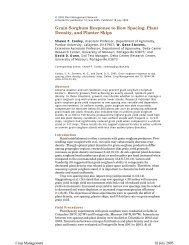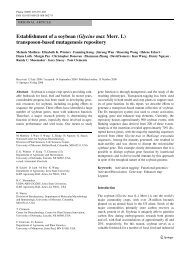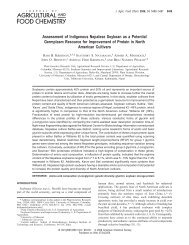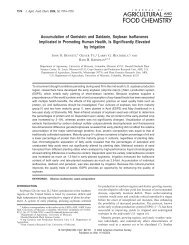Development of marker-free transgenic sorghum ... - Plant Sciences
Development of marker-free transgenic sorghum ... - Plant Sciences
Development of marker-free transgenic sorghum ... - Plant Sciences
You also want an ePaper? Increase the reach of your titles
YUMPU automatically turns print PDFs into web optimized ePapers that Google loves.
98 <strong>Plant</strong> Cell Tiss Organ Cult (2009) 99:97–108<strong>sorghum</strong> events from 300 immature embryos using animproved protocol employing a standard binary vector(with hpt as the selectable <strong>marker</strong>), cold pre-treatedimmature embryos and activated charcoal. Four additionalstudies (Gurel et al. 2009; Jeoung et al. 2002; Gao et al.2005a, b) used positive selectable <strong>marker</strong>s (i.e. the Escherichiacoli phosphomannose isomerase (pmi) gene and thegreen fluorescent protein gene (gfp). Recently, heat treatment<strong>of</strong> immature embryos prior to infection with A.tumefaciens has been used (Gurel et al. 2009).Although each <strong>of</strong> these studies has contributed to <strong>sorghum</strong>transformation, none have enabled production <strong>of</strong>large numbers <strong>of</strong> <strong>marker</strong>-<strong>free</strong> <strong>transgenic</strong> <strong>sorghum</strong> plantsusing standard binary vectors. In the present study, wedescribe the use <strong>of</strong> standard binary vectors with bar as aselectable <strong>marker</strong> and the <strong>sorghum</strong> public line P898012 toestablish a rapid and reproducible A. tumefaciens-mediatedtransformation system that generates large numbers <strong>of</strong><strong>transgenic</strong> <strong>sorghum</strong> events and <strong>marker</strong>-<strong>free</strong> progeny insegregating generations.Materials and methodsVectors and bacterial strainsThe binary vector pZY102 with the GUS-intron gene(Zeng et al. 2004) (http://plantsci.missouri.edu/muptcf/pzy101.html) was used to evaluate transformation parameters.Two vectors containing an altered tRNA lys and a<strong>sorghum</strong> lysyl tRNA synthetase (Wu et al. unpublished)were also constructed and employed: the pBluescript vectorwas digested with KpnI and Ecl136II to remove theKpnI and Ecl136II (SacI) sites. Each fragment was ligatedwith an adaptor incorporating two ScaI sites and a singleBglII site, respectively, to generate the shuttle vector, SBSpBS.An intermediate binary vector, Bin19(-), was firstgenerated by removing a 2,047-bp fragment between Pme Iand ClaI sites from Bin19 vector (Frisch et al. 1995). Thetwo restriction sites were then filled in with Klenowpolymerase fragment and ligated and inserted into the BglIIsite <strong>of</strong> SBS-pBS, generating pSBS19(-). The altered tRNAgene (TC2) or <strong>sorghum</strong> lysyl tRNA synthetase (SKRS)gene fragments were inserted into the HindIII-KpnI site<strong>of</strong> SBS19(-), generating SBS-TC2 and SBS19-SKRS,respectively. The ScaI fragment from SBS-TC2 or SBS19-SKRS containing T-DNA left and right border region wasthen inserted into the Sca I site <strong>of</strong> the standard binaryvector pZY101(Vega et al. 2008) that contains the bar geneas a selectable <strong>marker</strong> to generate vectors pZY101-TC2(Fig. 1a) and pZY101-SKRS (Fig. 1b), respectively. Thethree vectors, pZY102, pZY101-TC2 and pZY101-SKRSwere mobilized into A. tumefaciens strain EHA101(Hood et al. 1986) and their integrity within A. tumefacienswas confirmed by restriction enzyme digestion.<strong>Plant</strong> materialsThe public <strong>sorghum</strong> line P898012 was used for all transformationexperiments. All plants (except for those used inexperiments L73-L79, which were grown in the field duringthe summer) were grown in greenhouses at the University<strong>of</strong> Missouri, Columbia, Missouri, with day/nighttemperatures <strong>of</strong> 26/21°C, a photoperiod <strong>of</strong> 16 h light/8 hdark, in 3-gal pots containing Promix soil mixed with 2 oz.<strong>of</strong> Osmocote (14-14-14). About 32–35 days after planting,2 oz. <strong>of</strong> iron sulfate and 2 oz. <strong>of</strong> Osmocote (18-6-12) weremixed with the top portion <strong>of</strong> the soil <strong>of</strong> each pot; the soilmoisture and plants were checked daily and watered asneeded. Embryos were isolated from immature panicles,11–14 days after pollination.TransformationThe procedure reported here is based on the work <strong>of</strong> Zhaoet al. (2000) and Cai et al. (2002). Table 1 summarizesthe general procedure, cultivation periods and formulation<strong>of</strong> the media. A key modification was the use <strong>of</strong> lowlevels <strong>of</strong> glufosinate-ammonium (DL-phosphinothrithin,PPT, Aventis CropScience) at a concentration <strong>of</strong>2.5 mg l -1 in combination with a shortened selectionperiod (4–8 weeks). Other modifications included: (1) cocultivationmedium (TM) was overlaid with a piece <strong>of</strong>sterile filter paper, (2) reduction <strong>of</strong> MS salts to 2.15 g l -1in the infection medium (IM) and TM, (3) addition <strong>of</strong>PVPP to final concentrations <strong>of</strong> 1 or 0.5% in all mediumpreparation, with the exception <strong>of</strong> IM, (4) Trans-Zeatinribosidesubstitution for zeatin in shooting medium (SM),(5) elimination <strong>of</strong> selection agent in SM, and (6) no use<strong>of</strong> PHI-V (extended selection medium, CM with PPT10 mg l -1 , instead) or PHI-W (regeneration medium, CMsupplemented with kinetin 0.5 mg l -1 ; Zhao et al. 2000).Briefly, A. tumefaciens strain EHA101 harboring standardbinary vector was clonally isolated from a -80°C glycerolstock onto an AB minimal medium (Chilton et al.1974) plate containing appropriate antibiotics. The platewas incubated at 28°C for 3 days until single coloniesdeveloped. This master plate was used on a weekly basisfor up to a month. For the inoculation, a single colonywas streaked out onto YEP (5 g l -1 yeast extract,10 g l -1 peptone, 5 g l -1 NaCl, and pH 7.0) containingthe same antibiotics as the AB plate. The YEP plate wasthen incubated at 20°C for 2–3 days until bacterial coloniesdeveloped fully. A. tumefaciens colonies were thentaken from the YEP plate, suspended in 5 ml <strong>of</strong> IM123








